Top>Education>Cultivating competency through project-format exercises
 Index
Index
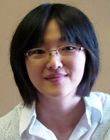
Mizuyo Takamatsu [profile]
Cultivating competency through project-format exercises
Mizuyo Takamatsu
Assistant Professor of mathematical engineering, Faculty of Science and Engineering, Chuo University
Education program to cultivate autonomy in students
In order to cultivate competency in students, Department of Information and Systems Engineering conducts project-format exercises which are known as Image Contents Laboratory. This series of exercises consists of from Exercise 1 to Exercise 4. Each of the 4 exercises is performed by students in the second term of their 2nd year, the first term of their 3rd year, the second term of their 3rd year, and the first term of their 4th year, respectively. This article will focus on Exercise 4, discussing features of the exercises and conditions of students enrolled in the exercises.
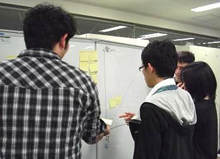
Photograph 1: Team conducting brainstorming
The theme of Image Contents Laboratory 4 (hereinafter referred to as "Contents Laboratory") is "using OpenGL to create games which move on glasses-free 3D display." Students in each team consult with each other to decide the contents and program specifications of the games. Students often play games in their daily life, so they quickly form images of the type of games that they want to create. Photograph 1 shows a team of students conducting autonomous brainstorming and discussing ideas for games. Students actively raise opinions about the types of games that they want to create and the types of functions which they want to include. Every year, each of the teams has extremely lively discussion.
An interesting aspect of these discussions is that almost all students focus on the ideal game which they want to make, rather than games which they can actually make with their own ability. This is quite different from normal classes. In the case of reports for normal classes, a large number of students are satisfied with simply reaching the level set by their instructor. However, in the ideal form of university education, classes are an opportunity for students to acquire an interest in academic subjects. Based on this interest, students take the initiative to acquire new knowledge and learning. Similarly, instead of simply solving problems assigned by the instructor, students in Image Contents Laboratory work hard based on their own desire to learn and create. This is the ideal form of university education.
Teamwork which utilizes individuality
Problems assigned in normal classes can be solved by utilizing the knowledge learned in that class. However, in Image Contents Laboratory, there is no guarantee that students possess the ability to create what they want. Although it is best if students recognize this discrepancy when they decide on specifications, there are many cases in which students have this realization when actually writing the program. In such cases, students in normal classes may ask their instructor for hints regarding the assigned material, assuming that the instructor knows the answer. Other students may rationalize their inability by saying "not being able to do something we haven't learned is normal." However, since students themselves decide on the contents of games in Image Contents Laboratory, they feel responsible for finding their own solution. Also, even if their individual ability is insufficient, students believe that consulting with other team members may make the work possible. This is another strongpoint of teamwork.
Another point which elicits the autonomy of students is that sample answers do not exist for problems in Image Contents Laboratory. Normally, when all students solve the same report problem, students compare their understanding of classes, or their speed and accuracy of solving problems. They are not able to freely ask questions or hold discussions. However, in the case of teamwork, each student can handle the work which they are skilled at. Students no longer wither away due to comparison with others. They become more confident and able to freely state their own opinions. This leads to active discussion.
Cultivating practical ability for performing in society
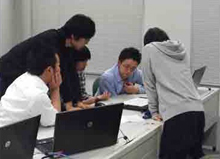
Photograph 2: Team discussion
Another feature of Image Contents Laboratory is the many opportunities for presentation and discussion. Firstly, after each group decides on the contents which they will create, they give a presentation to the instructor and other teams regarding the game which they will make. Through questions from the instructor and other teams, students notice points which they have overlooked and develop new ideas. Furthermore, by creating the opportunity for asking questions about the other teams' presentations, students develop the ability to ask questions. This ability is essential when working in society.
When designing the system, students often become uncertain about how they should form the program. In such cases, team members consult with each other and hold small-group discussions (Photograph 2). Such discussion is training for conveying one's own opinion in an easy-to-understand manner, as well as for correctly understanding the opinions of others. Through discussions with their friends, many students realize that their opinions are difficult for others to understand. As a result, students become conscious of giving easy-to-understand explanations.
Presentations to alumni
The climax of Image Contents Laboratory is giving presentations to invited alumni. During the presentations, each team uses posters to explain their game to alumni, graduate students and students in other teams. Q&A sessions are then held. Furthermore, the audience actually tries the game. Every year, the presentations are extremely lively and resemble the poster sessions of academic conferences. Photograph 3 shows the game demonstration, while Photograph 4 shows the poster session. For students, it is a valuable experience to answer questions from alumni who have worked at corporations for many years. Students are able to learn about the perspective of working professionals. By accumulating such experiences while still in undergraduate school, students are able to hone from an early stage the presentation techniques and communication ability which will be essential in the near future.
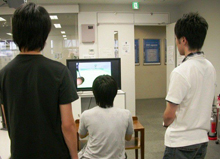
Photograph 3: Demonstration
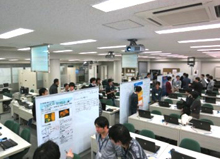
Photograph 4: Poster session
Improving competency through Image Contents Laboratory
In this way, Image Contents Laboratory integrates opportunities for cultivating problem-solving ability, communication ability, discussion ability, and presentation techniques. All of these skills are essential for graduate research and careers. One student enrolled in Image Contents Laboratory gave the following impression of the class: "This class gave me the greatest sense of my own ability increasing." In Image Contents Laboratory, student will see greater results the harder that they work. Moreover, students directly understand that abilities acquired in the class will be useful in their career. This understanding makes it possible to maintain high motivation. Image Contents Laboratory is an opportunity to effectively improve competency through active effort by ambitious students.
Image Contents Laboratory introduced in this article is positioned as an implementation course for the Rubric-based Competency Development Education Program. The programs for competency education at Chuo University have been summarized in the electronic book "Competency Development as a Model of Scientific Global Education," which is published by Hakumon Shobo and can be downloaded for free. This book was written in order to introduce a portion of Chuo University's scientific education method to a wide audience, both domestic and overseas. The contents of the book are also useful for educational staff at junior and senior high schools, as well as for corporate employees who are engaged in personnel affairs.
*The link listed below is slightly less than 5MB. We recommend first right-clicking and selecting "Save link as," and then opening the saved PDF file.
- Mizuyo Takamatsu
Assistant Professor of mathematical engineering, Faculty of Science and Engineering, Chuo University - Born in Tokyo in 1982. In 2005, graduated from Faculty of Engineering, the University of Tokyo.
In 2007, completed the Master's Program at Graduate School of Information Science and Technology, the University of Tokyo.
In 2010, completed the Doctoral Program at Graduate School of Information Science and Technology, the University of Tokyo. Holds a PhD (information science and technology). Assumed her current position from 2010.
Holds a PhD (information science and technology). Assumed her current position from 2010.
Member of the Operations Research Society of Japan, the Japan Society for Industrial and Applied Mathematics, and the City Planning Institute of Japan. Conducts research in application of combinatorial optimization and matroid theory, as well as mathematical modeling for a variety of problems which arise in the real world.
- Research Activities as a Member of Research Fellowship for Young Scientists (DC1), Japan Society for the Promotion of Science (JSPS) Shuma Tsurumi
- Important Factors for Innovation in Payment Services Nobuhiko Sugiura
- Beyond the Concepts of Fellow Citizens and Foreigners— To Achieve SDGs Goal 10 “Reduce Inequality Within and Among Countries” Rika Lee
- Diary of Struggles in Cambodia Fumie Fukuoka
- How Can We Measure Learning Ability?
—Analysis of a Competency Self-Assessment Questionnaire— Yu Saito / Yoko Neha - The Making of the Movie Kirakira Megane








